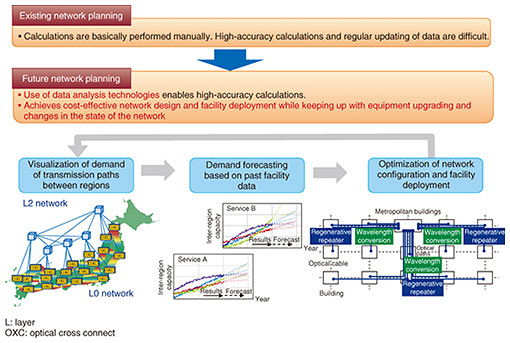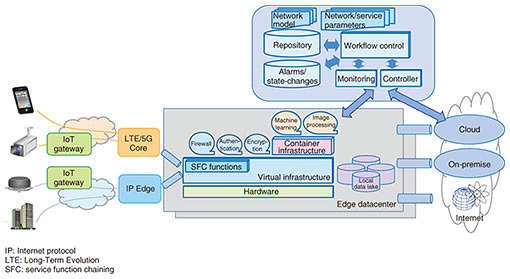 |
|
|
|
|
|
Feature Articles: Network Technology for Digital Society of the Future—Research and Development of Competitive Network Infrastructure Technologies Vol. 17, No. 6, pp. 23–26, June 2019. https://doi.org/10.53829/ntr201906fa7 Optimal Design and Control of Network ResourcesAbstractNTT Network Technology Laboratories is researching and developing technologies for flexibly tracking network changes on various timescales with the aim of achieving a network with high facility usage efficiency and enhanced convenience of use. This article introduces optimal network design technology and cloud native SDx (software-defined-anything) control technology as specific examples of technologies under study. Keywords: optimization, optical network, SDx control 1. IntroductionWith the coming of a full-scale fifth-generation mobile communications (5G)/Internet of Things (IoT) era, studies are underway at the NTT laboratories on architecture that can respond flexibly to changes occurring in the various stages of network operation. This article reports on the following technologies. (1) Optimal network design technology To deal with long-term changes in demand, this technology visualizes the cost effectiveness of facility investment based on actual data and supports the formulation of optimal facility investment planning. (2) Cloud native software-defined-anything (SDx) control technology This technology optimally allocates the resources needed for providing services such as networks and cloud environments in response to short-term changes in demand and automatically configures settings for a wide variety of patterns through workflow control. 2. Optimal network design technologyOptimal network design technology is applied in order to conduct studies on optimal facility investment, equipment deployment policies, and network topology in response to long-term (several months to several years) changes in the state of the network due, for example, to increases in communications demand. The conventional approach has been to rely on highly skilled and experienced operators to conduct these studies. However, to provide a flexible network in a sustainable manner in the face of a declining population and changes in society, the need has arisen to carry out even more advanced studies without the need for skilled personnel through data analysis technologies such as artificial intelligence (AI). To solve this problem, the NTT laboratories are using actual facility data to 1) visualize and predict changes in facility usage conditions, 2) analyze ways of improving facility usage efficiency, and 3) enhance the optimization of network-configuration and facility-deployment proposals without skilled personnel. At the latest NTT R&D Forum held in November 2018, we presented the concept of optimal design technology targeting the transport network, the visualization and forecasting of changes in facility usage conditions, and analysis of areas of improvement in facility usage efficiency (Fig. 1).
3. Cloud native SDx control technologyThe idea behind cloud native SDx control technology is to automate the immediate provision and maintenance/operation of services spanning the cloud and network. We are studying in particular the following topics: 1) a mechanism for automatically controlling the resources needed for service provision (network/cloud resources, etc.), and 2) the need for a method of appropriately managing resource information, the target of control. With respect to the first topic above, we are studying a mechanism for handling the network and cloud environment and even applications for providing services through a sequence of operations by combining such technologies as network functions virtualization and software-defined networking. This mechanism will be based on technologies already being used on the cloud under the assumption that they can also be used to control the network. In addition, the resources needed to provide services, which may be of a physical type (computers, network devices, etc.) or a virtual type (virtual computers, software-defined network functions, etc.), need to be linked and controlled. To this end, we are studying means of modeling these target resources so that they can be handled in a general-purpose manner. In this way, we aim to provide flexible support for a wide range of services (Fig. 2).
At the NTT R&D Forum held in November 2018, we presented a scheme for achieving efficient operations when providing a new service or responding to a fault in the system. This scheme combines an automatic-control mechanism and optimal resource allocation function to perform optimal resource allocation based on information on the resources needed for responding to such an event and on the state of resources at the time of the event, and performs automatic control based on the results of that allocation. 4. Future outlookIn this article, we introduced optimal network design technology and cloud native SDx control technology, which will be applied to support the network infrastructure that is slated to become the social infrastructure of the future. These technologies will promote the digital transformation of network design and control through AI and will facilitate investment that keeps up with changes in the state of the network and in path design without the need for skilled personnel. Going forward, our plan is to perfect this technology through verification experiments with an eye to becoming the infrastructure technology of the full-scale 5G/IoT era. |
|















